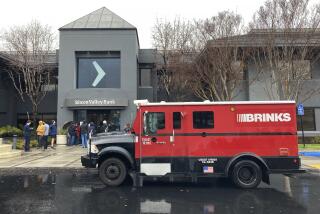The Sky’s the Limit With New Zoning
Above the city’s busiest commercial corridors is a vast and empty skyscape that Jane Blumenfeld has eyed for years now.
Blumenfeld, a Los Angeles city planner, visualizes that emptiness filled with residents who live above the corridors, perhaps patronize the shops below and commute on buses or subways that serve the streets.
Now, a new ordinance, part of a package approved by the Los Angeles City Council this week, will make it easier to build housing above retail buildings or to build housing-only projects on commercial streets.
The package is “a new tool that is really going to be meaningful and able to produce housing,” Blumenfeld said. “If you think of all those corridors -- especially Pico, Olympic, Exposition -- they’re wide and one story. What these [ordinances] are trying to do is get the potential that’s there to happen.”
The ordinances, approved Tuesday, are the result of a report released two years ago by the Los Angeles Housing Crisis Task Force. The document recommended that the Planning Department examine whether city codes impede housing production.
By right, developers were already allowed to build housing in commercial zones.
But such projects were rare because, under the old system, builders had to apply for variances -- special permits that allowed them to build outside certain specifications governing square footage, building height or how far the structure had to be set back from the street. The process required hearings and could take months, but generally the projects were well-received in their neighborhoods, Blumenfeld said.
The creation of the new mixed-use zones, which would apply only to commercial areas, allows for such projects to be built without such permits. In addition to retail businesses, the zones allow for child-care centers and other neighborhood services on ground floors.
Councilman Ed Reyes, author of the rezoning ordinance, said the new zones will bring relief to residents living two or three families to an apartment. They will also add to the city’s coffers, he said.
“A real byproduct is stimulating our tax base,” Reyes said. “How are we going to pay for 18,000 [police] officers when we now have 9,000?”
Supporters of the new zones include a list of housing-related organizations and tenants groups, as well as developers who view the zones as a way to increase the city’s housing stock.
The next step is to decide which areas will be rezoned. That determination will be made on a lot-by-lot or block-by-block basis, Blumenfeld said. Property owners, developers, council offices and the city Planning Commission may propose rezoning. A series of public hearings, environmental review and analysis would follow.
“Everybody’s voices will be heard before anything is rezoned,” Blumenfeld said.
Residents of some communities already seem poised to object. At a hearing held months before passage of the ordinance, some spoke against the new zones, fearing clogged streets and other problems associated with growth.
Although concerns exist in some neighborhoods, residents of areas plagued by overcrowding may welcome the change, Reyes said. The city averages 12 to 14 residents per acre, but in the southern end of his district the average is 147 people per acre, he said.
“I want to go where [the rezoning is] most easily implemented because the need is so great,” he said. “We are in a crisis. It’s a tale of two cities.”
The ideal place for such a zone would be near light- or heavy-rail stations or major intersections served by bus lines, he said. Theoretically, the zones will help relieve congestion and promote the use of public transportation, perhaps revitalizing blighted streets in the process.
For a city that has long prided itself on its neighborhoods of single-family homes -- and protected them -- focusing growth in commercial areas is a good way to meet the housing needs of an exploding population, Blumenfeld said.
“We have miles of these corridors all over the place,” she said. “We have so much capacity. We can deal with the amount of new people if we do this.”
After the ordinance goes into effect next month, the Planning Department will offer a workshop to explain the zoning to developers, lenders, architects and others.
Also this week, the City Council approved three other housing-related ordinances.
* One increases density bonuses for builders of housing near rail stations, major bus stops, commercial centers or universities. Under state law, developers are allowed to build more housing units in exchange for designating a certain percentage of them affordable. Under the new city ordinance, that rate increases from 25% to 35% in targeted locations.
* Another ordinance allows applications for density bonuses greater than 25%, increasing the potential for bonuses to more projects.
* The third eliminates a provision that had discouraged developers from building more three- to five-bedroom apartments, needed for large families.
More to Read
Start your day right
Sign up for Essential California for news, features and recommendations from the L.A. Times and beyond in your inbox six days a week.
You may occasionally receive promotional content from the Los Angeles Times.






